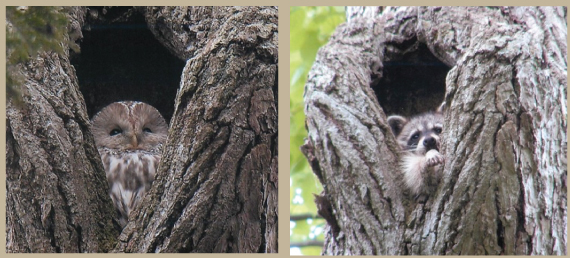Tree cavities as potential conflict zones: invasive raccoons and native owls competing over limited resources
Research Press Release | December 27, 2013

| Press Release | ||
|---|---|---|
| Key Points |
– Up until now, impacts of invasive species were concerned mainly with the competition between taxonomically related species with similar life styles, as well as predation on small organisms. However, this research looks at resource competition between medium-sized mammals and birds with apparently different life styles. – It was found that tree cavities were a site of competition between invasive raccoons and native owls and other birds. – This study draws attention to the hitherto overlooked influence of invasive species with the aim of assisting in the preservation and management of native ecosystems. |
|
| Overview |
Invasive species have spread native ecosystems the world over, and impact them in terms of predation and competition. However, most research on this to date has looked only at competition between taxonomically related species with similar life styles, or on the predation of small organisms. This study focused on resource competition between species with apparently quite different life styles—medium-sized mammals and birds of prey—the invasive common raccoon (Procyon lotor), an expert at tree climbing that uses trees for nesting and roosting, and the Ural owl (Strix uralensis). Of the 341 tree cavities in Nopporo Forest Park on the outskirts of Sapporo, 37 were found to be used by common raccoons, and 34 by Ural owls. Considerable overlap was discovered in the features each species considered important in selecting tree cavities. This indicated potential competition between the two species. Furthermore, it became apparent that the common raccoon used an extremely wide variety of tree cavities, providing grounds for concern about competition with not only Ural owls but also with numerous other native bird species. This study identifies the heretofore overlooked impact of invasive species, and will be useful in the conservation and management of native species. This study was aided by a grant from the Fujiwara Natural History Foundation, and appeared in the digital edition of Biological Invasions magazine on November 21. |
|
| Inquiries |
Itsuro Koizumi, Specially Appointed Assistant Professor, Creative Research Institution, Hokkaido University TEL: +81-11706-9247 FAX: +81-11-706-9272 E-mail: itsuro@cris.hokudai.ac.jp |
|
| Japanese Link | 外来アライグマと在来フクロウの意外な競合?! ―樹洞(樹木に空いた空洞)資源をめぐる潜在的な競争― | |
| Publications | Biological Invasions (2013.11.21) | |
